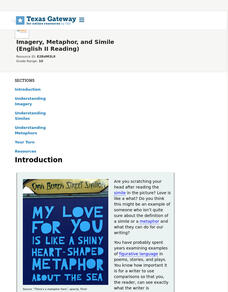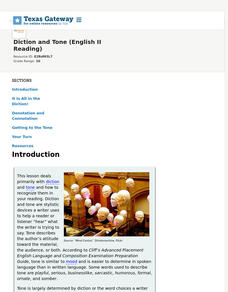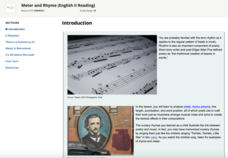Texas Education Agency (TEA)
Close Reading of Prose: Practice 2 (English II Reading)
The tone is easy to hear but more challenging to detect in written texts. Users of this interactive learn how to closely observe the diction and words writers use to convey their feelings about their subject. They examine passages that...
Texas Education Agency (TEA)
Imagery, Metaphor, and Simile (English II Reading)
The sixth interactive in this series introduces learners to the power of figurative language. After studying examples of similes and metaphors, readers examine how such comparisons help them see through a writer's eyes. Interactive...
Texas Education Agency (TEA)
Diction and Tone (English II Reading)
Words carry baggage. In addition to their literal, denotative meaning, words also carry the weight of the associations and connotations attached to the word—the connotations of words writers use to create the tone of a piece. An...
Texas Education Agency (TEA)
Syntax (English II Reading)
Lesson five in the series focuses on syntax and the elements that make sentences enjoyable. Learners practice building different clauses and phrases and using figures of speech and rhetorical and literary devices.
Texas Education Agency (TEA)
Annotate and Analyze a Paired Passage: Practice 1 (English II Reading)
What do a colt and a boy in a tree have in common? More than might be first apparent. The fourth interactive in a series of ten introduces readers to intertextuality, the process of using abstract thinking to consider how one text...
Texas Education Agency (TEA)
Isolated Scenes and Plot Support (English II Reading)
And the plot thickens! The third interactive in this series introduces young scholars to the cause-and-effect nature of a fictional story plot. They learn about the characteristics of exposition, rising action, climax, falling action,...
Texas Education Agency (TEA)
Archetypes, Motifs, and Plot in Drama (English II Reading)
The second interactive in a series of 10 introduces young scholars to character archetypes, archetypal plot patterns, and archetypal motifs, including the use of color. Learners read passages explaining the term and study examples from...
Texas Education Agency (TEA)
Meter and Rhyme (English II Reading)
Imagine an interactive that teaches young poets all the essential elements of poetry. This colorful resource does just that. Players are introduced to rhythm, meter, and rhyme schemes using famous poems. They practice marking the...
Utah Education Network (UEN)
Character Changes Lesson and iPad Assignment
Round, flat, static, dynamic. As part of a characterization study, scholars review the different types of characters and create a slide show demonstrating how a dynamic character in a story they have read changes throughout the tale.
National Endowment for the Humanities
Shakespeare's Julius Caesar: Leadership and a Global Stage
Shakespeare's Julius Caesar is, among other things, the study of a ruler's ambitions. Young scholars watch videos, read articles, and keep a Commonplace Book while studying the play. At the end of Act III, pupils stage the play that...
National Endowment for the Humanities
"From Citizen, VI [On the Train the Woman Standing]," Claudia Rankine
Claudia Rankine's poem "From Citizen, VI [On the Train the Woman Standing]," asks readers to consider direct and more subtle forms of prejudice. After discussing the format of the poem, its tone, and the emotions expressed, class members...
Academy of American Poets
Incredible Bridges: “Cotton Candy” by Edward Hirsch
Read it, hear it, see it, do it! Young poets experience Edward Hirsch's memory poem, "Cotton Candy," by first closely reading the poem silently, then aloud, watching a video of the poet reading it, and crafting their memory poem of an...
Utah Education Network (UEN)
8th Grade Poetry: Assess
Eighth graders craft a Petrarchan sonnet and respond to a performance assessment to demonstrate what they have learned in this five-instructional activity poetry unit.
Utah Education Network (UEN)
8th Grade Poetry: A to Z Poem
A two-part activity asks eighth graders first to draw connections between the myth of Aengus and William Butler Yeats' poem "The Song of Wandering Aengus." In the second part of the activity, writers craft an "A to Z Poem."
Utah Education Network (UEN)
8th Grade Poetry: Sonnet Poem
The third lesson of five in an eighth-grade poetry unit has young scholars comparing Shakespearean sonnets with Petrarchan sonnets. To begin, they examine the different structures of the two forms and their different rhyme schemes. After...
Utah Education Network (UEN)
8th Grade Poetry: Catalog Poem
After conducting a close reading of Billy Collin's poem "Forgetfulness" and responding to questions on a worksheet, young poets craft catalog poems and share their work with a partner. The lesson ends with the partner using the provided...
Utah Education Network (UEN)
8th Grade Poetry: Narrative Poem
The first lesson plan of a five-lesson plan unit designed for eighth graders has class members reading and watching a video of Edgar Allen Poe's narrative poem, "The Raven." They then craft their narrative poem, illustrate it, and share...
Teach Engineering
Cosmic Rhythm
Young engineers turn poets with a hands-on activity that challenges them to apply the concept of rhythm to crafting a poem.
Curated OER
Socratic Seminar
To conclude their study of the letters of Abigail Adams, class members engage in a Socratic seminar where they discuss her writings and what her letters reveal about her.
Curated OER
Modern Day Editing
Abigail Adams' letters reveal how the English language has changed and become more standardized over the last 200 years. To underscore this point, pupils edit one of Adams' letters
Curated OER
Abigail as Mother (Part II)
Different tones for different audiences. That's the big idea behind the second lesson in a two-part series that reveals Abigail Adams as a mother. Scholars examine letters Abigail Adams wrote to her sons, John Quincy Adams and Charles...
Curated OER
Abigail as Mother (Part 1)
In part one of a two-part series, scholars compare two of Abigail Adams' letters: one to her son and the other to her daughter. Researchers use the provided worksheets to contrast evidence of the tone and themes in the two letters.
Curated OER
Abigail Adams and Thomas Jefferson
In addition to her letters to her husband, family members, and friends, Abigail Adams also wrote to key political figures of the time. In this lesson, scholars examine letters Adams' wrote to and received letters from Thomas Jefferson...
Curated OER
Abigail and Mercy
Scholars examine three letters from Abigail Adams to Mercy Otis Warren, compare them to previous letters in the series, and note the change in tone in these letters she writes to her friend.












!["From Citizen, VI [On the Train the Woman Standing]," Claudia Rankine Lesson Plan "From Citizen, VI [On the Train the Woman Standing]," Claudia Rankine Lesson Plan](http://content.lessonplanet.com/resources/thumbnails/456347/large/u2nyzwvuc2hvdf8ymdizltazlte3x2f0xzeyljexljq2x1bnlnbuzw.png?1679080322)












